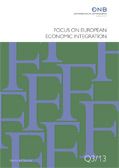Focus on European Economic Integration Q3/21
 OeNB
OeNB
- published:
- August 2021
 OeNB
OeNB
Call for applications: Klaus Liebscher Economic Research Scholarship (PDF, 62 kB) en Aug 30, 2021, 12:00:00 AM
Use of loan moratoria by CESEE households: who are the users and how vulnerable are they? (PDF, 792 kB) Allinger, Beckmann. Loan repayment moratoria were widely used during the COVID-19 pandemic to mitigate liquidity problems in the private sector and thus rapid asset quality deterioration in the banking sector. We provide novel, comparable survey evidence on the use of moratoria by households in ten Central, Eastern and Southeastern (CESEE) countries. In countries where eligible borrowers had to opt in to use moratoria, i.e. qualify and apply, 14% of borrowers did so on average; in countries where borrowers had to opt out, i.e. take action not to make use of automatically applied moratoria, take-up was 55% on average. We find that for opt-in moratoria, the main determinant of take-up is the degree to which borrowers’ finances were affected by the pandemic. Moratorium take-up is also strongly affected by the extent of indebtedness, particularly in opt-out countries. Using information on loan arrears, we show that individuals who had exited from their moratoria by fall 2020 were not more likely to be in arrears than those who never used moratoria. However, these results probably constitute the lower bound for loan defaults that may occur once all moratoria have expired. After all, we also find that borrowers whose moratoria were still active in fall 2020 were subject to more adverse shoc en household debt relief, moratoria, loan arrears G51, D14, G18, G28 Aug 30, 2021, 12:00:00 AM
What do people in CESEE think about public debt?
(PDF, 822 kB)
Eller, Jovanovic, Scheiber.
This paper investigates public attitudes toward public sector debt in ten Central, Eastern and
Southeastern European (CESEE) countries. Unique data from a special module of the 2018
OeNB Euro Survey wave indicate that people in CESEE have, in general, negative attitudes toward public debt. Most respondents believe that higher public debt compromises the opportunities of future generations and implies higher taxes or lower social benefits in the future. Beliefs that higher public debt allows for higher investments today are also widespread but less common. Econometric analysis reveals that wealthier individuals and more disadvantaged societal groups (particularly people who have experienced economic hardship) tend to be most concerned about public debt. The finding that the worse off are more debt averse contrasts with existing studies for advanced economies that have found that it is primarily the better off who are more skeptical. This difference may be explained by the comparatively lower level of social spending and the predominance of regressive tax systems in CESEE, which could make disadvantaged groups of society believe that the burden of higher debt must eventually be shouldered by them.
en
public debt, public preferences, survey data, CESEE
C42, D78, E62, H63, P35
Aug 30, 2021, 12:00:00 AM
Supplement to “What do people in CESEE think about public debt?” (PDF, 321 kB) Eller, Jovanovic, Scheiber. Expanding on the paper “What do people in CESEE think about public debt?” published in Focus on European Economic Integration Q3/21, this supplement addresses three additional topics: (1) potential data bias introduced by straight-lining behavior in the underlying OeNB Euro Survey,2 (2) summary statistics and bivariate correlations, and (3) further estimation results based on a narrower definition of baseline regressors, alternative estimators (ordered probit and generalized ordered probit) and alternative model selection methods (least absolute shrinkage and selection operator – LASSO). en Aug 31, 2021, 12:00:00 AM
European banks in Russia: developments and perspectives from 2017 through the COVID-19 pandemic (2020/2021)
(PDF, 311 kB)
Barisitz, Deswel.
Russia’s recent economic growth has been supported by the country’s banking sector, including
the European banks operating in the market. While Russia’s pre-pandemic GDP growth had suffered from a weak investment climate, oil price volatility and sanctions, the strong financial buffers built up in recent years were an asset for the country and its banking system during the pandemic-triggered recession. The European banks that qualify as significant institutions (Raiffeisenbank Russia, Rosbank/Société Générale and UniCredit Bank Russia), while pursuing different strategies, have remained committed to the Russian market. During the crisis, banking and economic activity were supported by temporary regulatory forbearance with respect to asset (loan) valuation and provisioning as well as the central bank’s key rate cuts and targeted government subsidies. European banks in Russia nevertheless keep facing exogenous risks, such as sustained compliance with sanctions regimes in a situation that remains volatile and sensitive to adverse geopolitical developments. Foreign currency fluctuations and the depreciation of the ruble require adequate risk management, and climate risk represents an emerging challenge. There is also strong competition driven by the digital transformation of banking. In March and April 2021, Russia’s central bank raised its key policy rate again amid rising inflationary pressures and signs of incipient economic recovery. Once regulatory lenience and lending subsidies expire, the banking sector would in general appear sufficiently capitalized to cover a potential increase of loan losses and provisioning needs. This goes especially for the European banks in Russia, which tend to have better-than-average asset quality and a sound capital base, although their market environment is expected to remain challenging. Besides, generous reserves remain at the disposal of the authorities should financial problems emerge, a scenario whose implications remain untested in the case of European banks due to their resilient performance.
en
banking sector, financial stability, COVID-19, crisis, credit risk, European banks, FDI, nonperforming loans, profitability, recovery, regulatory forbearance, restructuring, Russia, sanctions
G21, G28, P34
Aug 30, 2021, 12:00:00 AM
87th East Jour Fixe: CESEE’s second transition – challenges on the road to low- carbon economies (PDF, 131 kB) Breitenfellner, Lahnsteiner, Reininger. en Aug 30, 2021, 12:00:00 AM